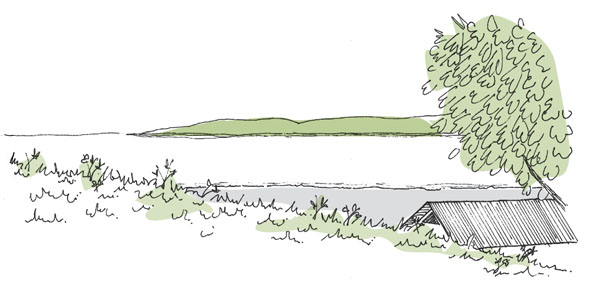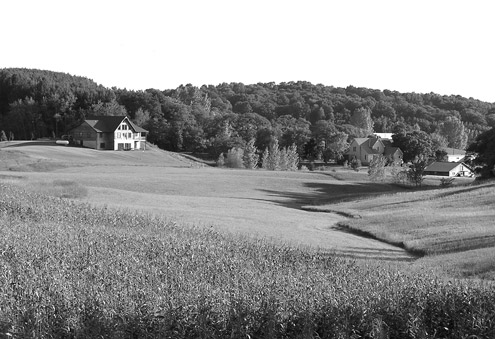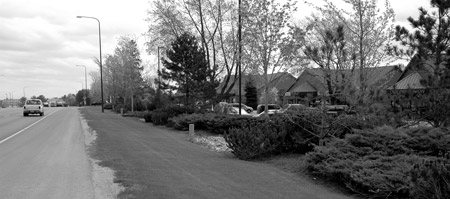|
Scenic Views & Development
Northwest Lower Michigan’s numerous scenic views are among the intangibles which help create our unique sense of place and draw people to the area year after year. A balance of economic development and environmental interests requires designing new developments in a way that maintains and benefits from scenic views and vegetated ridge lines.
|
|

Building sited to maintain scenic view
|
|
Scenic Views
Scenic views have two important characteristics. First, they have a focal point: a feature that is the object of a view (e.g., a landmark building, a streetscape, farmlands, a natural feature). Second, they have specific access points or areas from which the focal point is best viewed (e.g., scenic turn-outs, pathways, hilltops). When siting buildings, consider the structure’s relationship to unobstructed views which encompass large areas of land. Whenever possible, site buildings to retain and utilize significant views (e.g., open spaces, historic buildings, waterfront, parks). To preserve scenic views, local jurisdictions may consider altering setback requirements or other design guidelines (e.g., permitting higher structures when width is reduced) if doing so does not have a negative impact.
|
|
|

|
|
Hilllside Development
Development on hilly or sloping sites can visually impact a landscape significantly greater than the area bounded by property lines. Ridge lines, graceful and dramatic in their natural state, can be protected while allowing development under and within the tree canopy.
|
|
|

|
|
Roadway Development
Just as development throughout the region should complement the natural landscape, views along roadways should be pleasing, not visually chaotic. Corridor development should adhere to the same principles as other projects – the critical design practices which apply to development throughout the ten-county area regardless of type or location.
|
|
|
Key Points:
- Protect scenic views by setting aside open land or placing development where it has the minimum visual impact; clustering residential, commercial, and other development to retain open space; retaining naturally occurring vegetation to the maximum extent possible; and planting predominately native species in areas visible from roads.
- Local jurisdictions can preserve scenic views by purchasing conservation easements on shorefront property as it becomes available.
- Ridge development should minimize tree removal for structures and roads to maintain natural appearance.
- Structures should be tucked into natural vegetation (i.e., under the tree canopy) and landscaping used to minimize a development’s impact on the skyline.
- Due to the high visibility of hillside developments, special care should be given to site lighting. Refer to Critical Design Practices: Site Lighting & Utilities for additional information.
- To help maintain the regional character and scenic aspects of the surrounding area, avoid developing already barren ridges or do so with only very low density. Incorporate native landscaping to minimize the visual impact of site alterations and to revegetate previously cleared areas.
- For general information related to corridor development, refer to Critical Design Practices: Sign Design & Placement, Site Lighting & Utilities, Parking, and Roadways.
|
|
